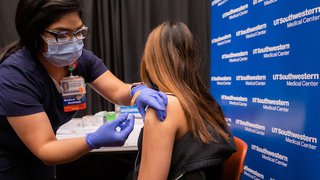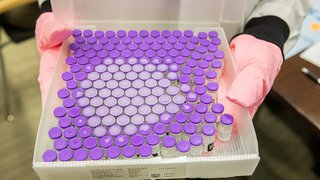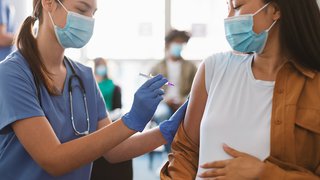
The old adage "Safe travels!" has taken on an extra dimension this summer as the COVID-19 pandemic continues to affect nearly every aspect of our lives.
Vacations and getaways will look very different this year. A survey by Travel Weekly found that 47% of would-be travelers are more likely to drive than fly in 2020, with 42% more likely to stay close to home on their road trip.
Luckily, there are lots of things to do outdoors – my family changed our international travel plans to take a trip to a national park. There are also plenty of great daytrips to take in Texas, where you can still enjoy fun in the sun and stay close to home without major risks to your health.
So, grab your mask and hand sanitizer and consider these five tips to have a safe, fun summer getaway, despite the pandemic.
1. Hit the road, Jack (or fly with caution)
No matter how you travel, check the CDC's COVID-19 tracker to see if your destination is a high-risk area. Several states are requiring a 14-day self-quarantine if you are coming from Texas.
Driving
When it comes to COVID-19 risks, traveling by car is safer than flying. Contain your car crew to just the people you live with, or if you're traveling with extended family and friends, make it a caravan of vehicles rather than everyone piling into the van.
Pad your typical road trip kit – load up on snacks, drinks, and entertainment for fewer stops. And be sure to pack extra hand sanitizer, disposable masks, and disinfectant wipes. Keep in mind that rest stops are potential hot spots for virus in the air and on surfaces. Do an extra-thorough wipe down if you have to use a public baby-changing station or a public restroom and wear your mask.
Even if you choose to travel more locally this summer, don’t forget to call before you make the drive. Many attractions are limiting hours, capacity, and requiring reservations to make it easier to maintain physical distances between patrons. See Texas COVID-19 case counts.
Flying
Another survey found that 61% of U.S. respondents planned to postpone vacation until travel restrictions are lifted – with 47% stating their first trips would be to visit friends and family.
Airports (as well as bus and train stations) are high-traffic areas where it can be hard to social distance. If you do fly, keep this mind:
Masks are strongly encouraged at Dallas and Fort Worth airports, but not required, which increases the level of risk for COVID-19 infection.
Some airlines are requiring masks on flights, but physical distancing is next to impossible on a plane, even though several airlines are leaving the middle seats open to create space between passengers.
Ultimately, if you’re going to fly do your best to control the controllables:
- Plan to wear your mask the entire time, in the airport and on the plane
- Skip the snacks – to eat, you'd have to touch your face (a COVID-19 no-no)
- Bypass beverages, even the first cocktail in first class, for the same reason
- Carry hand sanitizer (mind the TSA size limits!)
- Wipe the seats and tray table with disinfectant wipes
- Keep the flight short, if possible
If you're traveling internationally, follow CDC precautions and self-quarantine for 14 days to avoid potentially infecting others – even if you have no COVID-19 symptoms.

2. Look for low-key lodging
Try to stay at smaller hotels or motels, which will reduce the number of people gathered in one place. Ask the hotel about its COVID-19 cleaning practices. When you arrive, use disinfectant wipes to sanitize all high-touch surfaces, such as doorknobs, counters, and faucet handles. Repeat this as your family comes and goes-
3. Move the fun outdoors
As I’ve mentioned in previous COVID-19 articles, the risk of transmission outdoors appears to be significantly lower than indoors. COVID-19 is transmitted through small respiratory droplets in the air and on surfaces. So, consider traveling to some of the country’s wide open spaces.
If you visit a busy trail, park, or beach, try to keep at least six feet of separation between you and others not in your immediate family. Wear a mask when they venture closer. Instead of an indoor family reunion, consider an outdoor barbecue or rent an open-air pavilion. Keep your groups small (fewer than 10 people) and spread out as much as possible.
If you have family coming to visit you or they’re traveling from other states or countries, consider the risks associated with the places that they left. Is it a hot spot? Have they been physically distancing? It's OK to politely ask these questions. And if you're asked, be honest to avoid unintentionally spreading the virus.
4. Enjoy takeout or dining on patios
Indulging in local flavors is a favorite vacation activity, but it requires some precautions. When you’re on the road, consider opting for takeout meals, splurging on room service, or purchasing groceries from a local store so you can make fresh meals in your room.
If you do venture out to a restaurant, find a spot on the outdoor patio, sit at least a table apart from others if possible, and avoid community items, such as condiment containers or self-serve cups and snacks. Sanitize your hands regularly and wear a mask when you’re not eating.
Also, avoid touching reusable menus – look at their choices online instead. Or boost the restaurant's cleaning efforts by wiping off menus with disinfecting cloths.
The Summer of COVID-19 for Kids and Parents
Children who’ve been stuck at home since March are more than ready to dive into pool parties, sleepovers, and seeing friends again. But how will parents know what’s safe? UT Southwestern pediatric specialists Dr. Jeffrey Kahn and Dr. Rinarani Sanghavi join Dr. John Warner to discuss this hot topic.
5. Hunker down when you come home
After your adventure, you might need to self-quarantine to reduce risks to others. Consider where you've gone – was it a high-risk area? Were you potentially exposed? Do you have symptoms?
If the answer to any of these questions is yes, self-quarantine for 14 days to be safe. The CDC provides links to each state’s health departments, which should include information on COVID-19 cases and restrictions in that area. The average time from COVID-19 exposure to symptom onset is two to five days. Patients remain infectious for approximately 10 days. Not all infected people develop noticeable symptoms, so you may unintentionally spread the virus.
COVID-19 has ushered in a new normal, from how we work to how we vacation. As you navigate your family's pandemic summer plans, remember we can't live in a bubble, but we can do our part to keep ourselves, our families, and the residents of areas we visit safe. So wear a mask, avoid large gatherings, observe safe physical distancing, and practice good hand hygiene.
We all have the responsibility to take care of each other. Do your best, and try to enjoy your summer.
For more information about COVID-19, subscribe to our blog. If you need to see a doctor, call 214-645-8300 or request an appointment online.















